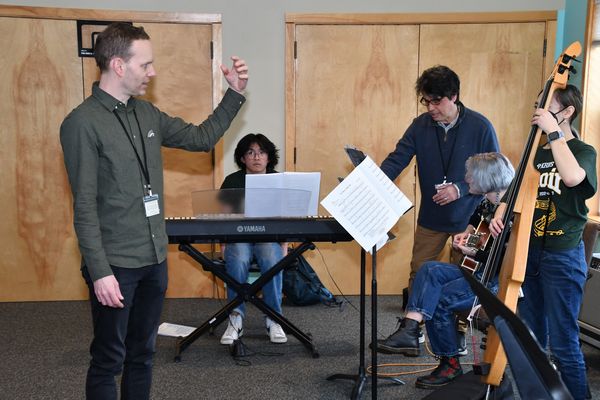

ArtsFund and Allen Family Philanthropies (formerly known as the Paul G. Allen Family Foundation) on Tuesday announced $10 million in funding to 930 grantees in the third year of the Community Accelerator Grant program — including the following from South Snohomish County:
Ballyhoo Theatre, $25,000
Cascade Symphony Orchestra, $12,500
Cascadia Art Museum, $2,500
DeMiero Jazz Festival, $5,000
Edmonds Arts Festival Foundation, $2,500
Edmonds Center for the Arts, $5,000
Edmonds Driftwood Players, $12,500
Edmonds Heights Performing Arts, $12,500
Morning Star Korean Cultural Center, $17,500
Olympic Ballet Theatre, $2,500
Phoenix Theatre, $25,000
Sno-Isle Libraries Foundation, $2,500
Sno-King Community Chorale, $2,500
This is the largest slate of awardees in the program’s history, with 19% being first-time grantees, according to a news release. Building on the successful $10 million pilot investment in 2023, and a second $10 million investment in 2024, the program has now infused a total of $30 million of unrestricted funding into Washington state arts and culture organizations.
Administered by ArtsFund and funded by Allen Family Philanthropies, the latest round of grants range from $2,500 to $25,000 in response to ongoing needs of arts and culture organizations. The unrestricted $10 million in funding will boost organizations’ abilities to invest in their missions and essential roles serving communities across the state, the news release said.
“Across the three years of this successful partnership with Allen Family Philanthropies, we have seen the breadth and depth of the arts across Washington,” said ArtsFund president and CEO, Michael Greer. “Having access to well-resourced arts organizations in every community impacts livability for all Washingtonians – from economic opportunities to social cohesion and connection. We are proud to support Washington arts and culture organizations and the multi-faceted impacts they make in their region.”
Grants were awarded to every eligible organization that applied. The average award size was $10,753. Approximately 74% of grantees reported annual budgets of less than $500,000 — this is a 5% increase from 2024, demonstrating the need for low-barrier, unrestricted grant programs for smaller arts and culture nonprofit organizations, according to the news release. For the first time in the program’s history, this year’s distribution includes organizations in all 39 counties throughout Washington.
“The incredible reach of this program into every corner of our state shows just how much this type of flexible funding is needed to bolster Washington’s rich and diverse arts and culture sector,” said Lara Littlefield, executive director of Allen Family Philanthropies. “This community-driven model now supports nearly a thousand organizations and the impact of their creative work, helping to make our local communities more vibrant and healthy.”
The application was designed to be low barrier, so that no organization would find it too cumbersome to apply. The ease and efficiency during the application and distribution process are major reasons that 91% of grantees from 2024 reapplied for this funding.
Participation also increased from every corner of the state with 612 grantees in Northwest Washington, 160 in Southwest, 87 in Eastern, and 51 in Central, including funding for 12 out of 29 (41%) of Washington’s federally recognized tribes. In addition, 18.5% of grantees this year are organizations located in rural counties (as defined by Washington State) and the program continues to focus on communities that have historically lacked access to funding.
The leading uses grantees cite for unrestricted funding, in order of priority, are programming; salaries and labor; and rent, mortgage and facility upgrades, with 85% of organizations citing programming or salaries and labor as their top needs. While the program does not require grant reporting, case studies are available that share more about past years’ recipients and how the awards impacted organizations.
A Community Advisory Panel consisting of 15 panelists from around Washington and the nation provided recommendations on the program’s grant application, eligibility criteria, award distribution, and community outreach strategies.
“Being a part of the Community Advisory Panel was a unique and insightful experience that will forever change the way I view how grants are distributed to organizations,” said Teal Sherrer, community advisory panelist and disability lifestyle writer. “So much thought and care was put into making the application process equitable. Beyond the design of the application, the intention to make the funding accessible to all communities across Washington is central to this program. At each stage of development, including the outreach, we focused on how to best minimize barriers so that the unrestricted funds could reach as many eligible arts and culture organizations as possible.”
Applications were considered based on representation of priority communities, geographic location, and alignment with program goals.
According to the Arts and Cultural Production Satellite Account, produced by the National Endowment of the Arts and the Bureau of Economic Analysis, the creative sector in Washington State contributes approximately $79 billion to the state’s GDP and is among the top in the nation. However, Washington State arts public spending falls 57% behind the national average according to ArtsFund’s Livability Impact Study of the Arts. Amidst the shifting landscape of arts funding, the Community Accelerator Grant program is intended to spur revenue generation for awardees. Applicants were asked to what degree they felt this grant might positively impact their ability to build capacity and increase their sustainability: Organizations anticipate raising an additional $2.70 for every $1 of their grant, resulting in a potential program impact of $27 million.
See the complete list of 2025 grant recipients HERE.

